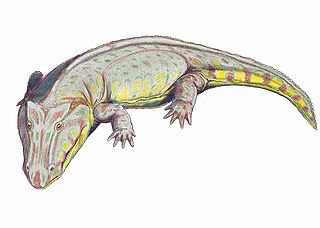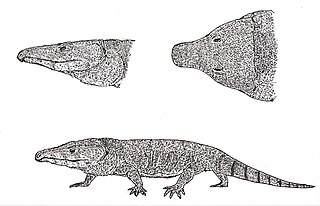This is a list of fossiliferous stratigraphic units in Niger .
This is a list of fossiliferous stratigraphic units in Niger .

Edops is an extinct genus of temnospondyl amphibian from the Late Carboniferous - Early Permian periods. Unlike more advanced temnospondyls of the time, such as Eryops, Edops exhibited an archaic pattern of palatal bones, and still possessed various additional bones at the back of the skull. Edopoids also had particularly big premaxillae and proportionally small external nostrils. Within the clade, the most basal member seems to be Edops from the Early Permian Archer City Formation of the US, a broad-skulled animal with large palatal teeth.

Capetus is an extinct genus of temnospondyl from the Upper Carboniferous of the Czech Republic. It reached a length of 150 cm.

Nigerpeton is an extinct genus of crocodile-like temnospondyls from the late Permian (Changhsingian) period. These temnospondyls lived in modern-day Niger, which was once part of central Pangaea, about 250 million years ago. Nigerpeton is a member of the Cochleosauridae family, a group of edopoid temnospondyl amphibians known from the late Carboniferous (Pennsylvanian) and early Permian (Cisuralian).
The Echkar Formation is a geological formation comprising sandstones and claystones in the Agadez Region of Niger, central Africa.

The Tiourarén Formation is a geological formation in the Agadez Region of Niger whose strata were originally thought to be Early Cretaceous. However, re-interpretation of the sediments showed that they are probably Middle or Late Jurassic (Bathonian-Oxfordian) in age. Other works suggested it reaches the Barremian. It is the uppermost unit of the Irhazer Group. Dinosaur remains & other vertebrates are among the fossils that have been recovered from the formation. Originally part of the "Argiles de l'Ihrazer", the Tiouaren Formation primarily comprises reddish to purple siltstones with occasional marls, limestones, and scarce channel sandstones.
The Dukamaje Formation is a geological formation in Niger and Nigeria whose strata date back to the Late Cretaceous. Dinosaur remains are among the fossils that have been recovered from the formation. A wealth of Mosasaur fossils have also been recovered from this formation, particularly from the area around Mt. Igdaman.
The In Beceten Formation, also Beceten or Ibecten is a Coniacian to Santonian geologic formation in the Iullemmeden Basin of Niger. It has yielded a diverse fauna and some angiosperms. Among others, it has yielded polypterifoms, urodeles, anurans, and turtles. Dinosaur remains are among the other fossils that have been recovered from the formation, although none have yet been referred to a specific genus. The lithology primarily consists of clays, fine limestones and sandy clays.

The Irhazer Shale or Irhazer II Formation is a Middle Jurassic geologic formation of the Irhazer Group in the Agadez Region of Niger. Fossil ornithopod tracks have been reported from the formation. The dinosaur Spinophorosaurus is known from the formation.
Christian Alfred Sidor is an American vertebrate paleontologist. He is currently a Professor in the Department of Biology, University of Washington in Seattle, as well as Curator of Vertebrate Paleontology and Associate Director for Research and Collections at the Burke Museum of Natural History and Culture. His research focuses on Permian and Triassic tetrapod evolution, especially on therapsids.

Edopoidea is a clade of primitive temnospondyl amphibians including the genus Edops and the family Cochleosauridae. Edopoids are known from the Late Carboniferous and Early Permian of North America and Europe, and the Late Permian of Africa. They are among the most basal temnospondyls, and possess a number of primitive features that were lost in later members of the group.

Bunostegos is an extinct genus of pareiasaur parareptile from the Late Permian of the Agadez Region in Niger. The type species, Bunostegos akokanensis, was named from the Moradi Formation in 2003. It was a cow-sized animal with a distinctive skull that had large bony knobs, similar in form to those of other pareiasaurs but far larger. The species appears to have lived in a desert in the centre of the supercontinent of Pangaea.
The Moradi Formation is a geological formation in Niger. It is of Late Permian age. It is informally divided into three subunits. The lower portion of the formation consists of red mudstone, with muddy calcareous sandstone and quartz-granlule conglomerate present as lenses. The middle portion consists of muddy siltstone in thick beds interbedded with red argillaceous sandstone. The lower two thirds of the upper portion of the formation consist of red siltstone intercalated with channel lag intraformational conglomerates, while the upper third consists of barchanoid shaped lenses of conglomeratic sandstone with ventifacts. These facies are indicatived of deposition under arid conditions, with less than 300 millimetres (12 in) of annual rainfall in the Central Pangean desert, with annual temperatures of 30 to 35 °C, but with ephemeral water presence including lakes.

Moradisaurus is an extinct genus of large captorhinid tetrapods, with a single species Moradisaurus grandis, known from the late Permian (Lopingian) aged Moradi Formation of Niger. It is the largest captorhinid known, estimated to have reached a snout-vent length of over two metres. Similar to other members of Moradisaurinae, it possessed multiple tooth rows, which is associated with a high-fiber herbivorous diet.